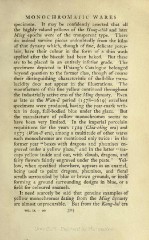Page 379 - Oriental Series Japan and China, Brinkly
P. 379
MONOCHROMATIC WARES
specimens. It may be confidently asserted that all
the highly valued yellows of the Hung-chih and later
Ming epochs were of the transparent type. There
do indeed survive pieces undoubtedly from the kilns
of that dynasty which, though of fine, delicate porce-
lain, have their colour in the form of a thin wash
applied after the biscuit had been baked. But these
are to be placed in an entirely inferior grade. The
specimens depicted in H'siang's Catalogue belonged
beyond question to the former class, though of course
their distinguishing characteristic of shell-like trans-
lucidity does not appear in the illustrations. The
manufacture of this fine yellow continued throughout
the industrially active eras of the Ming dynasty. Even
as late as the Wan-li period (15781619) excellent
specimens were produced, having the year-mark writ-
ten in deep, full-bodied blue under the glaze. But
the manufacture of yellow monochromes seems to
have been very limited. In the imperial porcelain
requisitions for the years 1529 (Chia-ching era) and
1573 (Wan-li era), among a multitude of other wares
such monochromes are mentioned only twice : in the
former year " boxes with dragons and phoenixes en-
graved under a yellow glaze," and in the latter " tea-
cups yellow inside and out, with clouds, dragons, and
fairy flowers faintly engraved under the paste." Yel-
low, when specified elsewhere, appears as an enamel,
being used to paint dragons, phoenixes, and floral
scrolls surrounded by blue or brown grounds, or itself
forming a ground surrounding designs in blue, or a
field for coloured enamels.
It need scarcely be said that genuine examples of
yellow monochromes dating from the Ming dynasty
are almost unprocurable. But from the Kang-hsi era
VOL. IX. 2O 35

